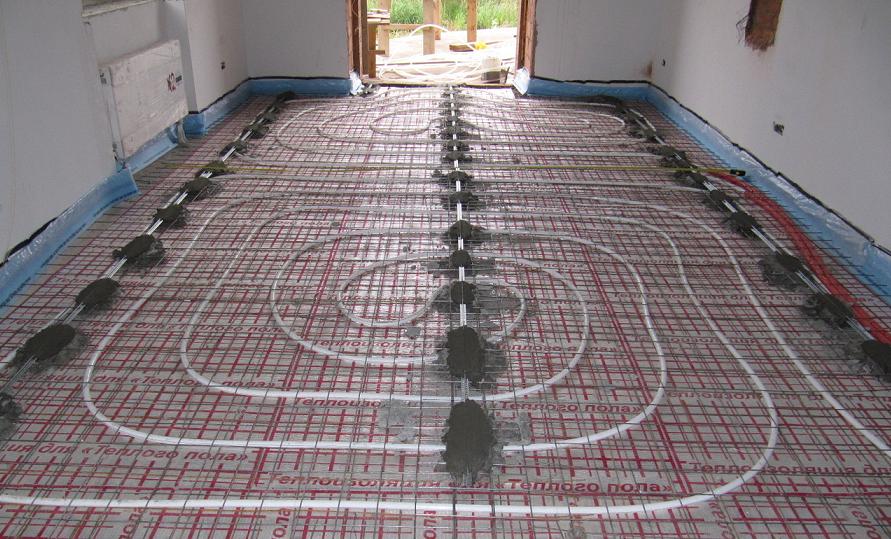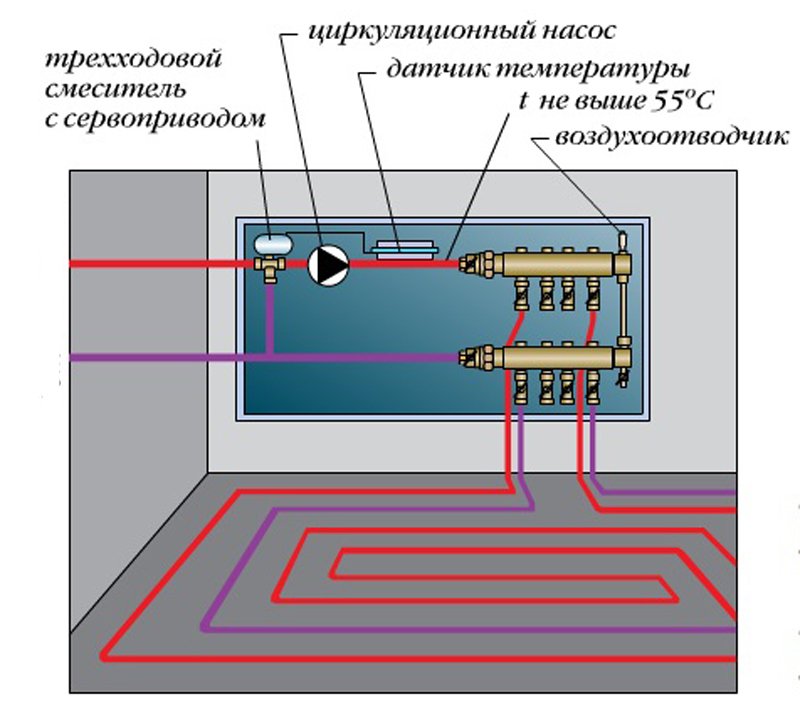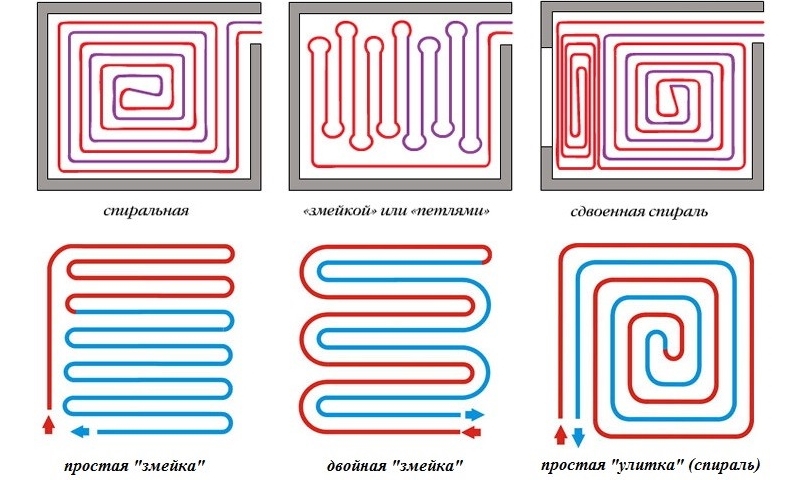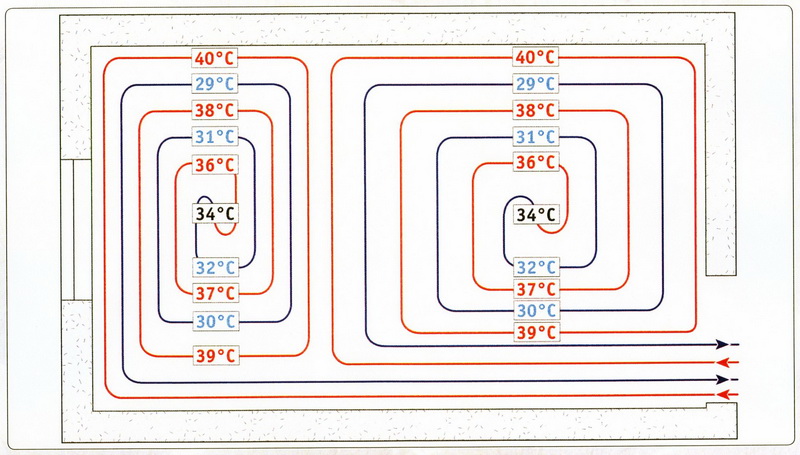Scheme and self-installation of a water-heated floor in a private house
The presence of underfloor heating will make it possible to abandon other heating devices, saving on their cost and freeing up usable space. How the scheme of a water-heated floor in a private house is arranged and how to mount it with your own hands, the information below will help you figure it out.
How does underfloor heating heat the air?
Underfloor heating is a new heating system that complements or replaces traditional convectors and batteries. This is a system of pipelines through which a heated coolant is pumped, as a rule, it is ordinary water or antifreeze. Pipes are laid on a substrate made of concrete, polystyrene or wood, and only then are finishing coatings.
The pipes through which circulation takes place are usually polymeric. The coolant is supplied from central heating or a system in which heating is performed by an individual boiler.
Warm air, warming up from the bottom of the floor, rises to the ceiling of the room. In this way, heat is distributed throughout the room. Its lower part warms up more than the upper one, it is very comfortable and useful to be in such a room. The scope of water heated floors is practically only in private houses, in an apartment there is a high risk of flooding of the lower rooms as a result of a pipe leak.
The system consists of pipelines and a coolant mixing point. The mixing unit is completed with a thermostatic mixer, pump and manifold. Sometimes a thermostat is needed. Pipes attached to the floor are poured with cement mortar. This screed distributes the heat received from the pipeline.
Seven "for" in favor of a warm floor

In comparison with traditional heating systems, a warm floor with a water coolant has a number of positive qualities:
- Profitability. When the room has high ceilings or a large area, a warm water floor is the best choice. Savings can reach up to 50 percent.
- Comfort. A room with a warm floor is heated more evenly, creating comfortable conditions for a person. When the heating comes from the radiators, the dwelling in the lower part does not warm up well, because the warm air immediately goes up.
- Safety. The circulation of the coolant occurs in pipes under the floor covering, even in the event of a leak, there is no risk of getting burned.
- Attractiveness. All elements are hidden and do not spoil the interior.
- Compatibility. Water floors can be used under most finishing materials.
- Price. Installing such a system will not require a very large budget.
- Versatility. Wiring diagrams for connecting to underfloor heating systems allow options for connecting to a boiler or a common system.
The disadvantages of such a system are not so many. The main disadvantage is the installation time, the system is multi-layered, and some require time delay. Difficulty may arise when leaks appear, it may be necessary to dismantle the floor covering.
Varieties of wiring diagrams for warm water floors

According to the type of material in which the pipes are laid, the main types of installation can be distinguished:
- in a concrete screed;
- based on polystyrene;
- along wooden rails.
The first type is the most reliable and common. A layer of heat and hydro insulation is laid on a flat surface. To strengthen the structure, a reinforcing mesh is laid. Next, pipes are laid and fixed with special brackets. The mounted system is poured with a solution of a mixture of cement and sand, and plasticizers can also be added to strengthen the screed. The best option for a decorative coating would be tile or stone.
Do not use a warm floor until the screed is completely dry, it may crack.
The next option is polystyrene-based installation. This option is the easiest to install. Pipes are installed in special ready-made forms. For mounting a single base, they are provided with engagement locks and additional fixation is not needed. After laying the pipes, heat-distributing plates are fixed on top, and then - the finishing floor covering.
The last option is mounting on a wooden base. The material is different - edged board, plywood or other wooden products. Strips are made from them and stacked on a wooden floor, with gaps under the pipes. At these intervals, the pipeline is fixed with special brackets. Next, the surface is covered with polyethylene and a layer of gypsum fiber, it will distribute the temperature evenly and the finish coat is attached to it.
On video: step by step installation instructions.
Connecting the system to the coolant supply and installing the collector
To figure out how to connect a warm floor to a heating system, you need to understand which elements of the system are involved in this. As in classical heating schemes, these elements are:
- heated coolant supply pipe;
- return pipe or return of the cooled coolant.
When the system consists of only one circuit, it is possible to connect it directly to the boiler. If there is more than one circuit, in order to ensure uniform distribution of the coolant, it is necessary to connect the underfloor heating collector to the coolant supply. The contours of the rest of the system, respectively, are attached to it.
First you need to choose the location of the collector. There are several accommodation options:
- arrangement of the manifold cabinet;
- installation in a niche in the wall;
- hanging wall mounting.
 Popular models of collectors are equipped with automatic thermoregulation. The kit will include temperature sensors and various measuring instruments. The distribution process of the coolant occurs automatically. A simplified diagram of the underfloor heating collector provides for a pair of thermometers and manual adjustment.
Popular models of collectors are equipped with automatic thermoregulation. The kit will include temperature sensors and various measuring instruments. The distribution process of the coolant occurs automatically. A simplified diagram of the underfloor heating collector provides for a pair of thermometers and manual adjustment.
To begin with, two pipes are connected to the collector - a return and a supply. After that, the "branches" of various pipelines are connected. To control and regulate the heating more precisely, it is necessary to connect a circulation pump, a three-way mixer and control valves.
For ease of repair and maintenance, shut-off valves are mounted in the pipe connection area, and a drain valve is provided at the end of the manifold. Such a system is powered by a boiler, and the temperature will depend on the temperature of the coolant supply.
Temperature controller in the system - installation rules
 In underfloor heating systems, the presence of a thermostat allows you to control the servo drive and regulate the supply of coolant to the system. This will automatically regulate the temperature in the room, as well as significantly save. In rooms with several heating systems, the presence of a thermostat is welcome.
In underfloor heating systems, the presence of a thermostat allows you to control the servo drive and regulate the supply of coolant to the system. This will automatically regulate the temperature in the room, as well as significantly save. In rooms with several heating systems, the presence of a thermostat is welcome.
They are electronic and mechanical. The temperature sensor included in the kit measures the heating of the air. It is mounted at a height of up to a meter, not far from the thermostat. The main thing is that there are no extraneous heat sources near the sensor. After fixing the sensor, attach it to the thermostat. After starting the heating, fix the desired temperature in the room on the thermostat.
How to choose a pipeline laying scheme
 Before starting the installation and arrangement of the "warm floor" system, it is necessary to familiarize yourself with the schemes for laying a warm water floor, their advantages and disadvantages. There are several such schemes:
Before starting the installation and arrangement of the "warm floor" system, it is necessary to familiarize yourself with the schemes for laying a warm water floor, their advantages and disadvantages. There are several such schemes:
- "Snake" - the pipeline is laid parallel to each other from wall to wall. Easy to install and design, but in this layout method there is a slight difference in surface temperature in some areas. This slightly reduces comfort and coziness. To stop such a negative moment, the design provides for a limitation on the temperature difference of the coolant in the supply and return.
- "Snail" - the pipeline is laid along the perimeter of the room from the walls to the center. More complex installation and design. But the heat distribution is more uniform, due to the alternation of pipes with a hot coolant and a cooled one.
- « Combined"- when both of these methods are used in the same room.
Any wiring diagram for connecting a warm floor to a heating system for laying a water-heated floor in a private house allows you to use the necessary of the above types, despite their pros and cons.
Parameters and nuances of the process of calculating a warm water floor
 To perform the correct calculation of a warm water-type floor, you need to take into account a lot of parameters and conditions:
To perform the correct calculation of a warm water-type floor, you need to take into account a lot of parameters and conditions:
- main or secondary heating;
- installation is planned in the house or apartment;
- what is the finish coat?
- what is the volume of the room;
- what is the purpose of the premises;
- what is the heat loss of the room.
Calculating the heat loss of a room is very important, especially if underfloor heating is the only heating system. To do this, you need to take into account the nuances:
- type of building materials of walls and ceilings;
- type of window frames and glazing;
- number of doors and window size;
- features of the climate of your region;
- availability of alternative heating systems.
 For premises of various types, a certain heating temperature of the coating is provided, namely:
For premises of various types, a certain heating temperature of the coating is provided, namely:
- living rooms - 30 degrees;
- in rooms where strong heating is needed - 36 degrees;
- with high humidity - 33 degrees;
- for natural wood - 27.
The choice of finishing coating material must be made at the stage of calculation, in advance. Otherwise, the heating power will be insufficient or it will be excessive.
Features of heating with underfloor heating imply an accurate thermotechnical calculation of the power of the system. This is especially true for rooms with wooden floors. Such a surface has low thermal conductivity and heating will be weaker at standard system power. Having studied all the nuances and paying attention to important points, you need to make an accurate calculation of the performance of the underfloor heating, heating equipment and calculate the step between the pipeline, taking into account the selected layout scheme. All this information will help you make heating with underfloor heating in a private house with your own hands.
 Masonry mortars for brick kilns
Masonry mortars for brick kilns Why do the windows fog up in the apartment
Why do the windows fog up in the apartment Construction and schemes of brick ovens
Construction and schemes of brick ovens How to lay paving slabs: tips and tricks
How to lay paving slabs: tips and tricks How to drill bathroom tiles
How to drill bathroom tiles Monolithic slab on coarse soil
Monolithic slab on coarse soil Which electric heater is economical
Which electric heater is economical